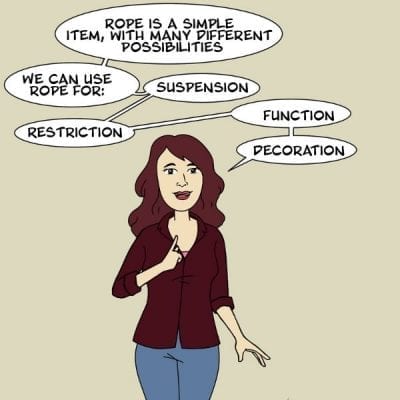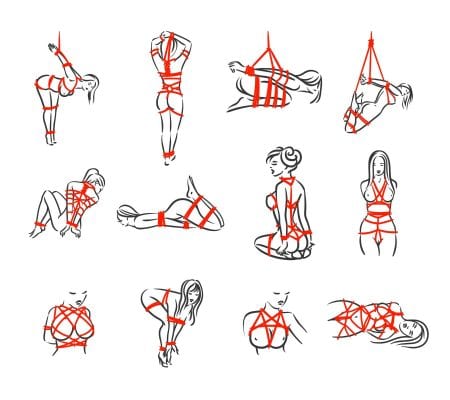If you imagine being on all fours with your knees tied to your elbows while your partner is playing with you, how does that make you feel?
What is bondage?
As you already know Bondage is a part of the BDSM subculture.
Bondage is a form of sex play in which one person restrains another for sexual pleasure.
Rope can be used for restraint, suspension, decoration, or function.
Also something simpler – like a scarf or a tie, can also be used (see things that can be used for bondage).
There is also a bondage tape, a tape that provides a fast and easy bondage tool. It can’t be used as a replacement for rope, however, it can be used as a restraint and maybe even as a decoration.
It can be as simple as having your arms cuffed but it can also go far as having your whole body restrained.
Types of bondage
- Bondage for a purpose – restraining the passive partner with purpose, making it easier to spank them, or making intimate parts accessible for sexual acts
- Decorative bondage – restraining someone to use him/her as an aesthetic object, most commonly as a human furniture
- Torture bondage – purposely bandaged in uncomfortable positions as a punishment in sub-dom relationships
- Speed bondage – used in some role-plays, such as kidnapping, where tying up is done quickly
- Film bondage – light, more for aesthetic reasons, easy to escape
- Suspension bondage – is a type of bondage where the bottom is suspended from one or more overhead points
Short (but essential) history of bondage
We were using ropes for many centuries and for many purposes, giving them their own history.
The usage of all kinds of ropes used to be as simple as restricting a thief and making him/her unable to run away.
The art of bondage though has a different history in different parts of the World.
For legal purposes, we are using the act of restraining to this day.
But the art of bondage also found a way to get into our bedroom. That is why we differentiate two basic or general bondages in use with your partner or in your sex life.
Western evolved for the purpose of torture.
It represents tying someone so you can do other things to them; such as spanking, teasing or performing sexual acts. Western bondage associates us to being overpowered or forced down.
Eastern represents a partnership for everyone involved.
The focus is on sensual art. The association in this type of bondage is on making the art come into being. A form of Japanese bondage – Shibari, is the most known example.
It took centuries to perfect this technique, which is an art of erotic spirituality, not a martial art.
What is Shibari?
Shibari is basically the art of Japanese rope bondage.
If you translate the word Shibari from Japanese it literally means “tied up”. There is an ancient saying in Japan: “binding the body, frees the soul”.
In Western culture, a person that ties someone in the context of sexual play is called a rigger.
Rigger is considered in charge or Dominant, while a person that’s being tied is considered submissive.
In Eastern culture, things are quite different. Everyone involved in bondage is considered a partner. In this situation, the rigger is considered a Rope master, and the whole play is centered on teamwork.
The whole erotic power exchange is seen as teamwork where everyone involved is getting a different type of pleasure and satisfaction.
What makes Shibari different than regular bondage?
First – looks.
With bondage as it is in Western culture, the focus is mainly on physical restraint.
We tend to not care if the knots are pretty, we just care if the person we want to tie is actually tied and restricted as we move forward with other aspects of our play.
With Shibari, we do care about looks.
Equal attention is paid to every knot. It’s done slowly, creating geometrical shapes which are in contrast with the human body.
Rope master is an artist that creates his art on a body. With his patterns and designs, he is showing strength, sensuality, vulnerability but also his respect.
Tying on the right spot is a second difference.
As bondage is usually used as one of a few different techniques during one play, not much attention is given to pressure points.
It’s more oriented to exploring other body parts and other sexual plays while restricted.
With Shibari, every knot is thought-out and positioned on pressure points to simulate.
Using pressure points is also popular in some forms of Japanese massage as well as in acupuncture.
Stimulating pressure points is known to counteract stress and help with relaxation.
Last but not least – state of mind.
While both bondage and Shibari bring a trance-like experience or as we like to call it “flying feeling”, Shibari is more focused on the spiritual.
The bondage itself or used with other plays and techniques bring euphoria to everyone involved.
The difference is that Shibari is exclusively focused on spiritual. The main interest is on getting that high and not on sexual activity.
The psychology behind bondage and why does it feel good?
Why does it feel so good to be restrained?
There are many types of research trying to figure that out.
Some of them say that while our bodies go through physical stress, they release endorphins.
A hormone whose function is to reduce our perception of pain. This makes our minds feel stress-free too. We often call that state of mind a “flying feeling”.
The bondage itself doesn’t always have to end with a sexual act.
The most important thing in the bondage game is TRUST, as one of the partners is completely vulnerable.
Some people are attracted by the fact that pleasure is given to them and they don’t have to think about giving pleasure.
Also, the feeling of immobility and helplessness can be a turn on.
For the person that is restricting, a turn-on can be the feeling of personal power, but pleasure and satisfaction can also come from seeing their partner tied up.
Bondage play as a form of roleplay
Many couples add some form of bondage to their bedroom play to spice things up.
This type of play is usually used as a form of foreplay and mostly includes mild bondage and sexual teasing.
What turns us on in this form of foreplay is the feeling of the temporary transfer of control and power.
Safety in bondage
Safety and consent are important in every sexual act, not just in bondage.
Here, we won’t talk about consent but we do want to recommend this article: Safety in BDSM; RACK, SSC, and PRICK
You should never do bondage with someone you just met. You should do it with someone you know and trust. If you are unsure about your wishes and desires, always say no. A person that respects you will understand.
With that being said there are some safety measurements that should be followed:
- Never leave a bonded person alone – make sure that you change positions at least once an hour for circulation issues
- Never bond too tight – check body parts for coldness and numbness
- Always make sure that a bonded person can normally breathe
- Make sure that a bonded person can be easily and quickly untied (in case of emergency) – always have a pair of scissors so you can cut the rope if there is a need to
- You should never be intoxicated for the safety of a person relying on you
- If you never tried it before – use some simple tools which you understand and know how to use
To make sure you know where not to tie a person it’s important to know where nerves and veins are in the body. A picture below will show you where you should never tie a person.
Being aware of the situation and knowing how important is to talk and agree with your partner makes every play enjoyable and fun. And at the end – that’s what is all about.
Bondage for beginners
Recently, we started explaining how to do beginner knots in bondage. There is not a lot of videos for now, but we’ll get to it. 🙂
How to tie bondage knots?
Thank you for reading and stay tuned for more. You can always subscribe to our newsletter to get new, important updates.
How to learn bondage?
Continue to our list of best books about bondage – we chose 11 essential ones.
Thank you for reading.


















Leave A Comment